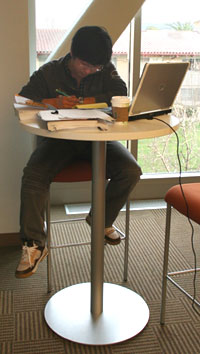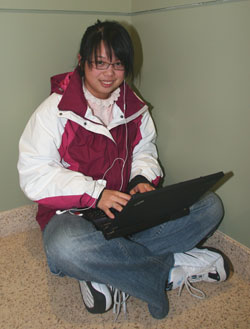Learning Amongst the Riches: Students in the Cloud
Students are moving away from their college or university, not physically, but in terms of their online “center.” More and more, they can engage independently in learning conversations using applications of their own choosing, and they can create their own digital identity that includes their learning spaces--all without using campus-based technology. This is a positive trend, and institutions need to get on the bandwagon. The trend away from dependence on a small number of campus-based software applications raises both technological and pedagogical issues, but it is both a good thing and it's inevitable.
The Institutional Cloud
For campus computing staff, moving basic institutional management services to the cloud alleviates some problems, e.g., not enough support staff, not the right kind of staff to support customization of software, not having the funds to add servers. But it also adds to problems of licensing and policy, e.g., determining who can use the software and when, and how to identify those who are licensed to use the software. You may not have to hire a developer once you’ve outsourced to the cloud, but you may have to hire a licensing czar.
From the campus management viewpoint, therefore, the cloud is a mixed bag. The trend is definitely toward outsourcing some important campus services, but the decisions regarding virtualization are usually based on cost, not on some philosophical benefit. For the academic side of the campus, however, the move to the cloud is a vital part of the stunning millennial educational revolution that began slowly a few decades ago and has reached take-off velocity in just the past couple of years.
The Academic Side of the Cloud
Students are finding ways to create their identities online, each student separately building his or her own identity socially and extending her/his learning opportunities (both formal and informal), while developing online literacy skills to maintain this identity semi-independently of higher education institutions.
But, most importantly, their learning experiences often involve a conversation, a process, and this conversation can include teachers and others with knowledge in their field. The skills students gain in the process are those they need to join a wider community and succeed in today’s economy.
Colleges and universities need to do more to incorporate social software into their courses and methodologies. I hear from faculty and administrators regularly about transformations of entire programs to the social/conversational/active learning paradigm of today.
A Return to “The Learning Conversation”
This extension of the learning conversation online (with blogs, wikis, e-mail, texting, chat, conferencing systems, portfolios, and so on), helps students develop online literacy skills. Though it is dependent on technology, it represents a return to the roots of human learning. Learning has always involved conversation. In fact, knowledge results from, or increasingly is, consensus-building through conversation.
Conversation among people interested in inquiry in the same field of knowledge is the basis for the idea of the university. For centuries, humans have depended on the printed word to extend the conversation. However, that conversation, if it can be called such while referring to the printed word, became so slowed down, it started to seem as though some contributions to the conversation were sacrosanct, the “last word” on a particular subject.
In the slowed-down conversation, knowledge started to harden and we academics started to think of knowledge as a product, a thing, a fixed corpus or canon. This perception affected how we taught. Students learned from experts, personified in their books, with whom they could not talk. Most students listened to people who were certified to interpret the experts because there were so few experts and so many learners. A lucky few got to listen to the experts themselves, directly.

|
As many commentators have noted, the new media, Web 2.0 apps, and the global spread of the Web are antidotes to the bottlenecked knowledge creation process in the centuries-long print era. In this century, we are starting to balance the carefully considered knowledge process of bookmaking with the more fluid and inclusive conversational knowledge process on the Web--both are necessary. We still have experts, but we also have the tools, knowledge sources, and conversations available so that many more people can become experts.
Student Ownership in the Cloud
To the extent that students are involved in that expert-making conversation as legitimate interlocutors, we educators are re-capturing something essentially human in the education process. To the extent that students are engaged in that conversation using their own--literally their own--Web and Internet applications, some of them have a chance to become independent, life-long learners and enjoy a better chance to develop their own expertise. In most fields, no learner is isolated or deprived of the essentials any longer. Still, to help students attain these benefits, we need to be conscious of the key question:
Why is it important for students to acquire their own Web applications in order to participate fully in the re-emergent, dynamic knowledge conversation today?
Look at the alternative: campus-based software (and where that takes us). All campus-based software, of necessity, must act as a good citizen as it interacts with the monolithic management software packages on campus, such as the student information system and the ERP (Enterprise Resource Planning system), or other centrally-managed software applications. This presents three problems for academic software: First, it usually means that the interface is more complicated than it needs to be if the software were not interfacing with large campus-based management systems. Secondly, the virtual space (that is, the imagined space) created by the software is institutionally owned, so it does not feel like it belongs to the student. Third, access to the software usually goes away after the student leaves the institution. Using institutionally-owned software applications can feel like borrowing a book from the library.
Contrast that with student-owned tools: Web 2.0 tools that students can own and manage themselves. They present an entirely different zeitgeist. If a college instructor designs a course that uses a wiki, for example, the interface is click-and-go, the space is “off campus,” and student access continues effectively for as long as the student desires.
Software companies supplying software for academic use on campus have a tradition of selling the software to the university, establishing the price based on a site license or a per-seat basis or other arrangements, but in all cases the institution is serving as a broker for the student. But now, some of these companies are beginning to sell directly to the students through a subscription model and serving the software from their own server site. This arrangement has a precedent in how books are sold to students. I still cannot throw out many of the books I bought as a graduate student, with my own marginalia, a kind of learning diary, and my name written inside the cover.

|
Finally, consider innovation (and where it comes from). In this century, given the economy we have now, innovation--not following orders or memorizing facts--is becoming rare and extraordinarily valuable. As students gain more control over their learning tools and therefore their intellectual property, their communications, their choice of collaborative partners, and their life’s work, they also gain greater scope and resources to stoke their imaginations and try out new ideas.
The cloud is where new learning conversations and related innovations are happening. Learning itself is becoming virtualized. Universities have a new role, but are as essential as ever: They are guiding learners in the process of learning amongst the riches.
[Photos of students at Santa Clara University's Harrington Learning Commons, Sobrato Technology Center, and Orradre Library by Mary Grush.]